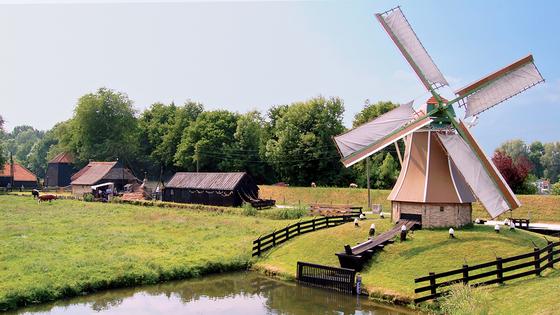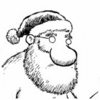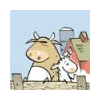Rick Steves’ Europe: Going Dutch in Holland’s Polder Country
Today my longtime Dutch friends Hans and Marjet are driving me through polder country. In these vast fields reclaimed from the sea, cows graze, narrow canals function as fences, and only church spires and windmills interrupt the horizon.
Hans is behind the wheel. He injects personality-plus into all he does, whether running a B&B or guiding Americans around Holland. Bouncy Marjet has a head of wispy strawberry-blonde hair, red tennis shoes, and a talent for assembling a Salvation Army-chic outfit for under $20.
As he drives, Hans talks about how people, including himself, call the entire country “Holland” when Holland actually comprises just two of the 12 provinces that make up the Netherlands. He says, “That’d be like me calling America ‘Texas.’” I bring up that most of America’s cliché images of the Netherlands come from the region properly referred to as Holland.
Looking out at the polder country, I remember that the word “Netherlands” means “lowlands.” This country occupies the low-lying delta near the mouth of three of Europe’s large rivers, including the Rhine. In medieval times, inhabitants built a system of earthen dikes to protect their land from flooding caused by tides and storm surges.
The fictional story of the little Dutch boy who saves the country by sticking his finger in a leaking dike summed up the country’s precarious situation. Many Americans know this story from a popular 19th-century novel, but Hans says few Dutch people have ever heard of it.
Chatting as we drive, I’m struck by how 10 minutes from Amsterdam, you can be in this wide-open polder land. It’s early summer, and the landscape is streaked with yellow and orange tulip fields.
Hans points out a quaint windmill along a sleepy canal. An old mill like this was used to turn an Archimedes screw in order to pump the polders dry. After diking off large tracts of land below sea level, the Dutch harnessed wind energy to lift the water up and out of the enclosed area, divert it into canals, and drain the land. They cultivated hardy plants that removed salt from the soil, slowly turning marshy estuaries into fertile farmland.
This area, once a merciless sea, is now dotted with tranquil towns. Many of the residents here are actually older than the land they live on, which was reclaimed in the 1960s. The old-time windmills, once the conquerors of the sea, are now relics, decorating the land like medallions on a war vet’s chest. Today, they’ve been replaced with battalions of sleek, modern wind turbines.
Several other Dutch icons came directly from the country’s flat, reclaimed landscape. Wooden shoes (klompen) allowed farmers to walk across soggy fields. They’re also easy to find should they come off in high water, because they float. Tulips and other flowers grew well in the sandy soil near dunes.
We head seaward, driving past sprawling flower-mogul mansions, then through desolate dunes. The little road dwindles to a sandy trailhead. Hans parks the car and we hike to a peaceful stretch of North Sea beach. Pointing a stick of driftwood at a huge seagoing tanker, Hans says, “That ship’s going to the big port at Rotterdam. We’re clever at trade. We have to be — we’re a small country.”
The Netherlands welcomes the world’s business, but the country is not designed for big shots. Hans explains, “Being ordinary is being prudent. We Dutch say a plant that grows above the grains gets its head cut off. Even our former queen prefers to do her own shopping.”
While Hans and I talk, Marjet skips ahead of us on the beach, collecting shells with the wide-eyed wonder of a 10-year-old. “Cheap souvenirs,” Hans teases. One cliché the Dutch don’t dispute is their frugality. Hans quizzes me: “Who invented copper wire?”
I know that one. “Two Dutch boys fighting over a penny.”
Hans points up the coast at a huge arc of mud shooting up from a ship. “We’re moving mountains of sand and mud to make our dikes stronger against the sea.” The frugal Dutch are, at heart, pragmatic. They spend their money smartly. In this era of global warming and rising sea levels, the Dutch are spending billions to upgrade their dikes and bulk up their beaches to hold back the sea. All this technological tinkering with nature reminds me of a popular local saying: “God made the Earth, but the Dutch made Holland.” They made it, and they’re determined to keep it.
Marjet scuffs through the sand, her pockets full of seashells, her scarf flapping in the wind like a jump rope. Under big, romping white clouds, I think, “Everything’s so ... Dutch.”
========
(Rick Steves (www.ricksteves.com) writes European guidebooks, hosts travel shows on public TV and radio, and organizes European tours. This article was adapted from his new book, For the Love of Europe. You can email Rick at rick@ricksteves.com and follow his blog on Facebook.)
©2022 Rick Steves. Distributed by Tribune Content Agency, LLC.
(c)2022 RICK STEVES DISTRIBUTED BY TRIBUNE MEDIA SERVICES, INC.














Comments